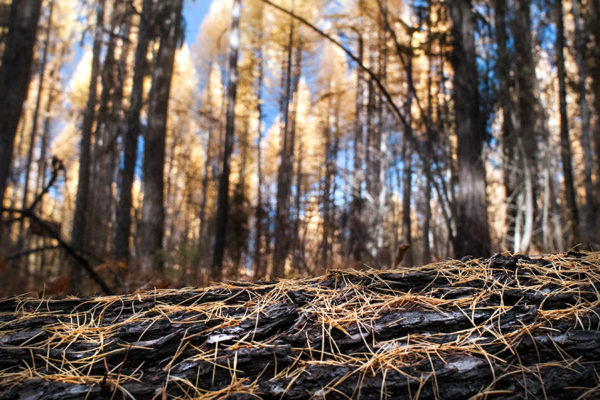When the seasons change from summer to fall, all eyes are on the hills and mountainsides in the Flathead and nearby valleys as the trees put on an autumnal light show, scattering bursts of oranges, yellows and reds through the blue-green forest.
And though Montana’s mountains are filled with evergreens, swaths of those hillsides reveal deciduous trees as they turn golden in the autumn chill, each almost taking on the glow of a flame as it changes.
Western larch have captured imaginations for centuries; a deciduous conifer that looks like an evergreen, a larch tree’s needles lose their chlorophyll in the fall, showing bursts of yellow and orange before the needles drop for the winter.
“You just can’t go past one and not say, ‘How cool is this?'” said Sonja Hartmann, nursery manager at Glacier National Park’s Native Plant Nursery and co-treasurer for the Flathead chapter of the Montana Native Plant Society.
The Flathead chapter hosted a Sept. 30 field trip to explore and enjoy local larch trees at the Coram Experimental Forest’s International Larix Arboretum, where participants learned to identify the characteristics of at least eight types of larch. The varietals have different traits, from cones to needles, that may not be immediately obvious at a quick glance.
“They are pretty magical,” Hartmann said.
Here are some quick facts about these enchanting trees:
Larch or Tamarack?
Technically, out here in Northwest Montana, they’re probably going to be Western larch, according to Montana Fish, Wildlife and Parks. True tamarack trees — Larix laricina — are not native to Montana or the Northwest U.S. Western larch — Larix occidentalis — grow here, whereas Tamaracks are the eastern varietal.
But they’re close relatives, all part of the Larix family, and Hartmann said it doesn’t really matter what you call them unless you’re trying to be particularly specific. Most people use the terms interchangeably.
“You can call anything anything and you’re not going to be necessarily wrong,” she said. “It’s a naming conundrum, of how technical do you want to be.”
The word “tamarack” is found all through the Flathead Valley, from businesses to events. Bigfork celebrates fall each year with the festival Tamarack Time!, taking place this year on Oct. 14, and Seeley Lake has hosted an annual Tamarack Festival as well.

Larix
Latin name for larch
10
Species of larch grow in the cooler regions of the northern hemisphere
3
Species groups for larch, including Eurasian, East Asian and North American
150 feet
Height that larch have been recorded reaching in Montana
153 feet
Height of the country’s largest Western larch, nicknamed Gus, which lives in the Seeley Lake area and is estimated to be at least 1,000 years old
Lyall’s Larch
Another type of larch tree found in Montana, also called alpine larch
Hackmatack
Another name for tamarack trees, which also go by eastern larch, black larch, red larch, or American larch
2
Nearly triangular seeds under each scale of a larch cone
Roots
Larch root systems run deeper than those of lodgepole pine, spruce or fir; in August 1995, a small tornado in the Swan left only larch standing
